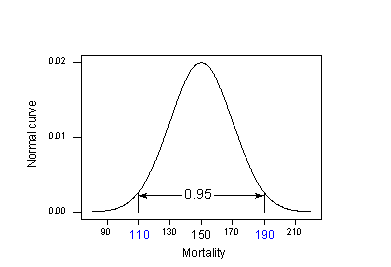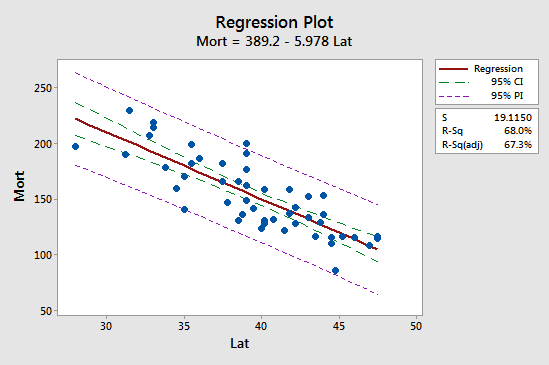In this section, we are concerned with the prediction interval for a new response, \(y_{new}\), when the predictor's value is \(x_h\). Again, let's just jump right in and learn the formula for the prediction interval. The general formula in words is as always:
Sample estimate ± (t-multiplier × standard error)
and the formula in notation is:
\(\hat{y}_h \pm t_{(1-\alpha/2, n-2)} \times \sqrt{MSE \times \left(1+ \frac{1}{n} + \dfrac{(x_h-\bar{x})^2}{\sum(x_i-\bar{x})^2}\right)}\)
where:
- \(\hat{y}_h\) is the "fitted value" or "predicted value" of the response when the predictor is \(x_h\)
- \(t_{(1-\alpha/2, n-2)}\) is the "t-multiplier." Note again that the t-multiplier has n-2 (not n-1) degrees of freedom because the prediction interval uses the mean square error (MSE) whose denominator is n-2.
- \(\sqrt{MSE \times \left(1+ \frac{1}{n} + \frac{(x_h-\bar{x})^2}{\sum(x_i-\bar{x})^2}\right)}\) is the "standard error of the prediction," which is very similar to the "standard error of the fit" when estimating \(\mu_Y\). The standard error of the prediction just has an extra MSE term added that the standard error of the fit does not. (More on this a bit later.)
Again, we won't use the formula to calculate our prediction intervals in real-life practice. We'll let statistical software such as Minitab do the calculations for us. Let's look at the prediction interval for our example with "skin cancer mortality" as the response and "latitude" as the predictor (Skin Cancer data):
Prediction for Mort
Regression Equation
Mort = 389.2 - 5.978 Lat
Settings
| Variable | Setting |
|---|---|
| Lat | 40 |
Prediction
| Fit | SE Fit | 95% CI | 95% PI |
|---|---|---|---|
| 150.084 | 2.74500 | (144.562, 155.606) | (111.235, 188.933) |
The output reports the 95% prediction interval for an individual location at 40 degrees north. We can be 95% confident that the skin cancer mortality rate at an individual location at 40 degrees north is between 111.235 and 188.933 deaths per 10 million people.
When is it okay to use the prediction interval for the \(y_{new}\) formula? Section
The requirements are similar to, but a little more restrictive than those for the confidence interval. It is okay:
- When \(x_{h}\) is a value within the scope of the model. Again, \(x_{h}\) does not have to be one of the actual x values in the data set.
- When the "LINE" conditions — linearity, independent errors, normal errors, equal error variances — are met. Unlike the case for the formula for the confidence interval, the formula for the prediction interval depends strongly on the condition that the error terms are normally distributed.
Understanding the difference in the two formulas Section
In our discussion of the confidence interval for \(\mu_{Y}\), we used the formula to investigate what factors affect the width of the confidence interval. There's no need to do it again. Because the formulas are so similar, it turns out that the factors affecting the width of the prediction interval are identical to the factors affecting the width of the confidence interval.
Let's instead investigate the formula for the prediction interval for \(y_{new}\):
\(\hat{y}_h \pm t_{(1-\alpha/2, n-2)} \times \sqrt{MSE \times \left( 1+\dfrac{1}{n} + \dfrac{(x_h-\bar{x})^2}{\sum(x_i-\bar{x})^2}\right)}\)
to see how it compares to the formula for the confidence interval for \(\mu_{Y}\):
\(\hat{y}_h \pm t_{(1-\alpha/2, n-2)} \times \sqrt{MSE \left(\dfrac{1}{n} + \dfrac{(x_h-\bar{x})^2}{\sum(x_i-\bar{x})^2}\right)}\)
Observe that the only difference in the formulas is that the standard error of the prediction for \(y_{new}\) has an extra MSE term in it that the standard error of the fit for \(\mu_{Y}\) does not.
Let's try to understand the prediction interval to see what causes the extra MSE term. In doing so, let's start with an easier problem first. Think about how we could predict a new response \(y_{new}\) at a particular \(x_{h}\) if the mean of the responses \(\mu_{Y}\) at \(x_{h}\) were known. That is, suppose it was known that the mean skin cancer mortality at \(x_{h} = 40^{o}\) N is 150 deaths per million (with variance 400)? What is the predicted skin cancer mortality in Columbus, Ohio?
Because \(\mu_{Y} = 150 \) and \( \sigma^{2} = 400\) are known, we can take advantage of the "empirical rule," which states among other things that 95% of the measurements of normally distributed data are within 2 standard deviations of the mean. That is, it says that 95% of the measurements are in the interval sandwiched by:
\(\mu_{Y}- 2\sigma\) and \(\mu_{Y}+ 2\sigma\).
Applying the 95% rule to our example with \(\mu_{Y} = 150\) and \(\sigma= 20\):

95% of the skin cancer mortality rates of locations at 40 degrees north latitude are in the interval sandwiched by:
150 - 2(20) = 110 and 150 + 2(20) = 190.
That is, if someone wanted to know the skin cancer mortality rate for a location at 40 degrees north, our best guess would be somewhere between 110 and 190 deaths per 10 million. The problem is that our calculation used \(\mu_{Y}\) and \(\sigma\), population values that we would typically not know. Reality sets in:
- The mean \(\mu_{Y}\) is typically not known. The logical thing to do is estimate it with the predicted response \(\hat{y}\). The cost of using \(\hat{y}\) to estimate \(\mu_{Y}\) is the variance of \(\hat{y}\). That is, different samples would yield different predictions \(\hat{y}\), and so we have to take into account this variance of \(\hat{y}\).
- The variance \( \sigma^{2}\) is typically not known. The logical thing to do is to estimate it with MSE.
Because we have to estimate these unknown quantities, the variation in the prediction of a new response depends on two components:
- The variation due to estimating the mean \(\mu_{Y}\) with \(\hat{y}_h\) , which we denote "\(\sigma^2(\hat{Y}_h)\)."(Note that the estimate of this quantity is just the square of the standard error of the fit that appears in the confidence interval formula.)
- The variation in the responses y, which we denote as "\(\sigma^2\)."(Note that quantity is estimated, as usual, with the mean square error MSE.)
Adding the two variance components, we get:
\(\sigma^2+\sigma^2(\hat{Y}_h)\)
which is estimated by:
\(MSE+MSE \left( \dfrac{1}{n} + \dfrac{(x_h-\bar{x})^2}{\sum_{i=1}^{n}(x_i-\bar{x})^2} \right) =MSE\left( 1+\dfrac{1}{n} + \dfrac{(x_h-\bar{x})^2}{\sum_{i=1}^{n}(x_i-\bar{x})^2} \right) \)
Do you recognize this quantity? It's just the variance of the prediction that appears in the formula for the prediction interval \(y_{new}\)!
Let's compare the two intervals again:
Confidence interval for \(\mu_{Y}\colon \hat{y}_h \pm t_{(1-\alpha/2, n-2)} \times \sqrt{MSE \times \left( \frac{1}{n} + \frac{(x_h-\bar{x})^2}{\sum(x_i-\bar{x})^2}\right)}\)
Prediction interval for \(y_{new}\colon \hat{y}_h \pm t_{(1-\alpha/2, n-2)} \times \sqrt{MSE \left( 1+\frac{1}{n} + \frac{(x_h-\bar{x})^2}{\sum(x_i-\bar{x})^2}\right)}\)
What are the practical implications of the difference between the two formulas?
- Because the prediction interval has the extra MSE term, a \( \left( 1-\alpha \right) 100\% \) confidence interval for \(\mu_{Y}\) at \(x_{h}\) will always be narrower than the corresponding \( \left( 1-\alpha \right) 100\% \) prediction interval for \(y_{new}\) at \(x_{h}\).
- By calculating the interval at the sample's mean of the predictor values \(\left(x_{h} = \bar{x}\right)\) and increasing the sample size n, the confidence interval's standard error can approach 0. Because the prediction interval has the extra MSE term, the prediction interval's standard error cannot get close to 0.
The first implication is seen most easily by studying the following plot for our skin cancer mortality example:

Observe that the prediction interval (95% PI, in purple) is always wider than the confidence interval (95% CI, in green). Furthermore, both intervals are narrowest at the mean of the predictor values (about 39.5).